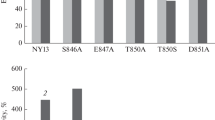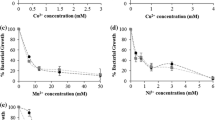Abstract
Cells of Saccharomyces cerevisiae exibited a more active plasma membrane H+-ATPase during growth in media supplemented with CuSO4 concentrations equal to or below 1 mM than did cells cultivated in the absence of copper stress. Maximal specific activities were found with 0.5 mM CuSO4. ATPase activity declined when cells were grown with higher concentrations up to 1.5 mM (the maximal concentration that allowed growth), probably due to severe disorganization of plasma membrane. Cu2+-induced maximal activation was reflected in an increase of V max (approximately threefold) and in the slight decrease of the K m for MgATP (from 0.93 ± 0.13 to 0.65 ± 0.16 mM). The expression of the gene encoding the essential plasma membrane ATPase (PMA1) was reduced with a dose-dependent pattern in cells grown with inhibitory concentrations of copper, while the weakly expressed PMA2 gene promoter was moderately more efficient in cells cultivated under mild copper stress (1.5-fold maximal activation). ATPase was activated by copper despite the slightly lower content of ATPase protein in the plasma membrane of Cu2+-grown cells and the powerful inhibitory effect of Cu2+ in vitro.
Similar content being viewed by others
Author information
Authors and Affiliations
Additional information
Received: 6 May 1998 / Accepted: 14 September 1998
Rights and permissions
About this article
Cite this article
Fernandes, A., Peixoto, F. & Sá-Correia, I. Activation of the H+-ATPase in the plasma membrane of cells of Saccharomyces cerevisiae grown under mild copper stress. Arch Microbiol 171, 6–12 (1998). https://doi.org/10.1007/s002030050671
Issue Date:
DOI: https://doi.org/10.1007/s002030050671




